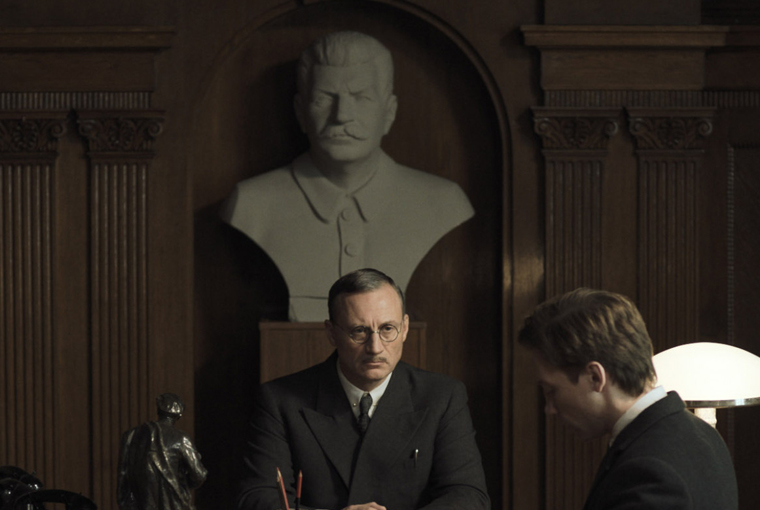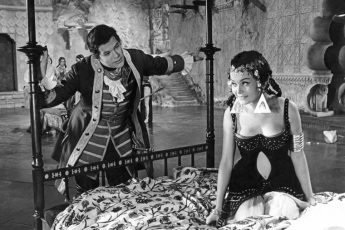Mr. Loznitsa’s Wax Museum of Terror
Sergei Loznitsa’s Two Prosecutors (2025)
Vol. 152 (February 2025) by Moritz Pfeifer
Sergei Loznitsa’s Two Prosecutors stages a series of interrogations in Stalinist Russia during the height of the Great Terror, in 1937. The narrative revolves around a legal official, Kornev (Aleksandr Kuznetsov), who begins to doubt the righteousness of his work when he is summoned to visit a political prisoner in the Bryansk region. The title of the film refers to the institutional links between Kornev and Andrey Vyshinsky (Anatoliy Beliy), the Prosecutor General of the USSR, whom Kornev confronts in Moscow. Their story unfolds within a bureaucratic world of fabricated testimonies and false accusations.
Loznitsa opts for minimal camera movement, clean static shots, and a square 1.37:1 frame. Cinematographer Oleg Mutu used the ARRI Alexa Mini paired with Ultra Prime lenses, producing a crisp, high-resolution digital image with sharp edges and flat contrasts.1 The film’s visual grammar is formally pristine – faces are lit from the side or above, drawing attention to bone structure and uniform texture. But this sleekness works against the film’s claims to realism. The image has no grain and more often than not resembles the backlit perfection of a Netflix series. The human figures often appear lifeless, like hyperreal wax figures positioned in diorama-like sets.
The film was shot almost entirely in Riga. The interiors were filmed in the disused Brasa prison, originally built in 1905. While the structure’s worn cells and narrow corridors provide spatial credibility, the surrounding urban fabric breaks the illusion. Long exterior shots show an asphalted street in front of the prison riddled with potholes and uneven patches. In 1937, the USSR was only just beginning to experiment with asphalt in the largest Soviet cities, and even there it would have looked quite different. In one early sequence, the building meant to represent the headquarters of the Moscow prosecutor’s office is actually the post-war Ministry of Finance in Riga, constructed in the early 1950s in the Stalinist Empire style. On the pavement in front of the building we can see unistone tiles – modular concrete blocks commonly used in post-Soviet urban design. These aesthetic slips give the film the look of a themed attraction rather than a reconstruction. Squeezing this odd mix into a squared frame to make it appear historic comes close to a cinematographic form of revisionism.
The decor and mise-en-scène are similarly artificial. Everything is too carefully placed: ink pots and Stalin busts at right angles, sleek agit-prop posters decorating the hallways. In the office of the prison commander, we can see a poster reading “Stay vigilant!” (“Bud’ bditelʹnym!”), which was made by Joseph Serebriany in 1941, several years after the presumed setting of the movie. While similar posters certainly existed before the “Great Patriotic War,” they would commonly appear in civilian-mobilization contexts such as agitational stands, communal halls, and workers’ clubs, but not in internal-security offices. The wristwatches are another distraction. Wristwatches evolved out of pocket watches and in the late 1930s models produced by the First Moscow Watch Factory still looked very much like pocket watches.2 Kornev’s wristwatch resembles postwar designs, which had thinner bezels, polished dials, and finer straps.
The acting is no less fake. In one of the film’s weakest sequences, an old Bolshevik on the train to Moscow recounts how he once visited Lenin to ask for alms after being injured in the revolution only to be told to come back tomorrow. Apart from lacking any restraint in foreshadowing the fate that is to befall Kornev, the scene feels overly theatrical and declamatory: from the Bolshevik’s grimacing facial features to the stentorian delivery of his lines.
Loznitsa’s earlier work, especially his documentaries based on archival footage, gains power from montage and subtlety. Two Prosecutors, in contrast, tries to re-stage the past as ceremony and ends up with kitsch. While it is as laudable as it is timely to expose the machinery of terror, dressing it in recognizable décor turns genuine unease into something ornamental. This is a film that declaims the absurdities of a destructive bureaucracy only to trade its unsettling truths for polished tableaux and obvious moral reckonings.
- ARRI. (2025, May 26). ARRI remains the leading camera choice among Cannes 2025 winners. ARRI News. https://www.arri.com/news-en/arri-remains-the-leading-camera-choice-among-cannes-2025-winners ↩︎
- Watches of the USSR. (n.d.). First State Watch Factory. https://mroatman.wixsite.com/watches-of-the-ussr/first-watch-factory ↩︎




Leave a Comment